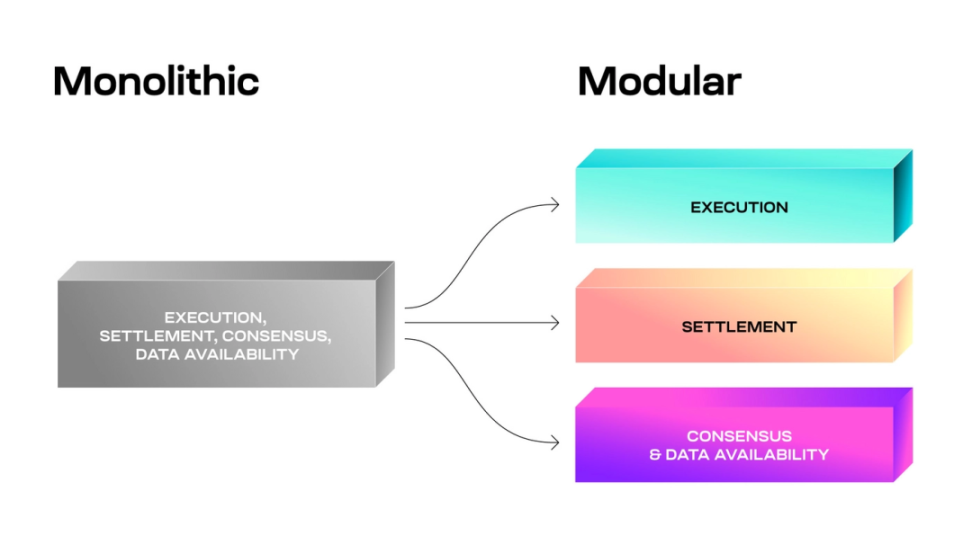原文作者:Terry
「正统性」,这个字面意义上与 Web3 精神相悖的词,近期开始越来越频繁地出现在大家的视野中。
尤其是加密社区掀起的关于以太坊 DA 正统性的大讨论,牵涉到 EigenLayer、Celestia 等一众如今的明星项目,甚至连以太坊联合创始人 Vitalik Buterin 都开始频繁发声,那究竟什么是 DA,围绕它的「正统性」争论究竟又意味着什么?
什么是 DA?
DA,就是数据可用性(data availability),是如今模块化区块链架构的重要组成部分。
不同于单体区块链,模块化区块链将一个区块链网络的不同部分拆分成对应的功能层,譬如执行(execution)、数据可用性(data availability)与共识(consensus)、结算(settlement):

单链和模块化区块链的对比,图源网络
执行:负责处理交易和状态更新的执行层;
数据可用性(DA 层):负责存储验证交易有效性所需数据;
共识:负责确定区块内交易排序和最终确认性,即确定内存池内的交易以何种顺序被包含在哪个区块内;
结算:负责验证 Rollup L2 状态数据和处理欺诈证明 / 有效性证明;
目前伴随着 L2 战争的升温以及模块化叙事的不断发展,专注于执行的 Rollup 或专注于数据可用性的 Celestia 等项目层出不穷。
而在模块化的世界里,数据可用性(DA)的核心功能,就是确保链上数据可供所有网络参与者使用和访问,以负责降低成本并扩展区块链。
那这样的好处有哪些?
首先自然是更加专业化,以数据可用性和执行的分离为例,在模块化架构中,可以完全由一组节点负责 DA,而另一组(或多组)节点负责执行,大家各司其职。在此背景下,专用的 DA 层除了实现更高的吞吐量之外,还可以提高互操作性,降低成本。
因为理论上讲,区块链网络中的每个节点都必须下载所有交易数据以验证数据是否可用,这是一项效率极低且成本高昂的任务,但也是大多数区块链目前的工作方式,也是可扩展性的障碍,因为验证所需的数据量随着块大小线性增加。
其次就是极大提升了可扩展性,使得每个区块链成为乐高积木,开发人员通过将专门的模块化链组合起来,可以构建更具可扩展性的区块链,通过 Caldera、AltLayer 和 Conduit 等 Rollup-as-a-service 提供商使部署新的 L2 变得越来越简单。
所以说白了,以以太坊的模块化为例,就是利用 L1 主链作为结算和数据可用性层,而以各式 Rollup 等 L2 解决方案作为执行层,以实现扩展。
这也是以太坊走向模块化区块链堆栈的路线图,一旦这一过渡完成,用户将能够使用 L2 的解决方案,同时仍然受益于以太坊基础层的安全性。
DA「正统性」大辩论
那为什么近期 Vitalik 和社区会产生关于 DA 的大讨论?大家争论的缘由是为何?
很简单,目前数据可用层的主流项目,除了以太坊之外(也即直接将状态数据和证明提交到以太坊 L1),还涌现出了 Celesita、EigenLayer 和 Avail 等新的解决方案。
而伴随着 Celestia 的发展,凭借可扩展性、主权性、灵活性、共享安全性等特性,在数据可用层方面对以太坊产生了竞争,并吸引一些通用性 Rollup L2 如 Manta、ZkFair 等转而采用 Celestia。
最直接的冲击,就是 Manta Pacific 将数据可用层从以太坊迁移至 Celestia 的「破窗效应」,这也是首个基于 Celestia 的 L2,引发了以太坊社区广泛讨论关注。

对 Manta Pacific 来说,这么做的动机无疑就是削减数据可用性成本——按照官方披露,自从将 DA 层迁移至 Celestia 之后,相较于使用以太坊主网,费用降低 99.81% ,堪称指数级下降。
当然,Celestia 这种第三方 DA 方案相较于以以太坊作为 DA 层的 Rollup 而言,肯定是牺牲了一定的安全性,但对这些 L2 的权衡来说,选用哪家 DA 事关成本和安全,但成本的影响占比无疑更为关键。
因此目前 Aleo、Dymension、ZKFair 等新项目就相继投身 Celestia 等新的 DA 解决方案来降低成本,甚至 Polygon 也选择转向 NEAR,并直言「比以太坊便宜 8000 倍」。

译文:比以太坊便宜 8000 倍!
我想知道这与 Celestia 等其他 DA 解决方案相比如何?
可以预见的是,只要成本优势持续存在,那未来集成 Celestia 等新 DA 解决的方案的 L2 会越来越多,这都给以太坊造成了不小的冲击,尤其是激起了以太坊社区与 Celesita 团队对以太坊 L2 定义权的争夺。
所以,DA「正统性」大辩论,简言之,就是关于通用性 Rollup L2 将 DA 层从以太坊换成 Celesita、Avail 等模块化区块链 DA 的争论。
背后的 DA 赛道发展暗线
总的来看,Celestia 等相关 DA 解决方案的百花齐放,确实在一定程度上削弱了以太坊 DA 的竞争力。
具体来看,对以太坊「正统性」产生冲击的也不止 Celestia,如果从宏观上对目前的 DA 赛道进行分类(刨除中心化方案),大致可分为四类:
以太坊 blob / Danksharding;
Celestia 等独立的去中心化 DA;
EigenDA/MantleDA ( 利用 ETH restaking 的 DA);
NEAR 等新秀;
其中 Celestia 自然不必多说,被不少社区用户视为给 L2 Gas 费用带来的巨大经济效益的「刚需」。
尤其是目前 Manta、ZKFair、Arbitrum Orbit、通用 L2 Eclipse、去中心化 API 数据服务协议 Pocket Network、模块化区块链网络 Movement Labs 等以太坊项目都已在使用 Celestia。
一旦形成规模效应,确实可能会不断侵蚀以太坊的费用收入,成长为一个专精的 DA 巨头,获得极高的估值溢价(以太坊损失的份额)。
除此之外,EigenDA 则充分利用了以太坊现有的基础设施,依赖于以太坊,通过 Restaking 延展以太坊的安全共识,因此本质上反而是在维护以太坊 DA 的「正统性」,增强以太坊的 DA 能力。
而 NEAR 也是一个「新」入局的种子选手,除了上文提到的 Polygon,Arbitrum Orbit 也已集成 Near DA,允许开发者基于 Arbitrum 的技术推出自己的可配置 Rollup。
总的来看,其实从 TIA 狂飙的市场价格,也能看出 DA 赛道伴随着 L1&2 的新格局演变,日渐走入大家的主流视野。
从这个角度看,关于 DA「正统性」的博弈也将成为 2024 年的一条主线叙事,甚至于演化出新的「以太坊杀手」,至于能否跑出怎样的新项目,让我们拭目以待。



